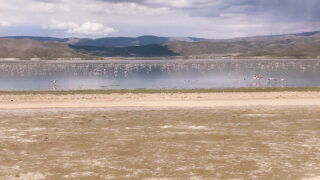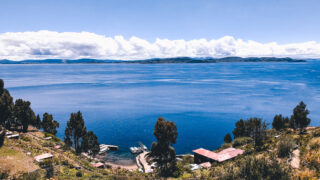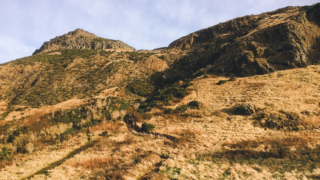Lake Titicaca once a sacred place for the Incas is one of South America’s largest lakes and the world’s highest navigable body of water. The freshwater lake spans between two of my favourite Latin countries, Bolivia and Peru. This leaves most travellers with a tough decision. Therefore I wanted to share why I chose to visit Lake Titicaca from Puno in Peru instead of Copacabana in Bolivia.
Puno and Copacabana are both towns build along the edge of the deep blue Lake Titicaca. There are many hostels located on Isla del Sol in Bolivia allowing you to experience the lake without a tour. While Puno has the unique floating reed islands, traditional dancing, and a homestay to offer.
Trying to figure out what to expect from visiting Lake Titicaca from Puno and Copacabana, what tours there are, what to expect from a two day-tour from Puno, the best time to visit, and if to hang around Puno? Read on to find out.

Post Contents
LAKE TITICACA, PUNO OR COPACABANA?
Ok, I admit there are many reasons why the Bolivian side of Lago Titicaca is arguably the more popular choice. Copacabana has birthplaces of Incan gods to offer. On Isla de la Luna Wiracocha created the moon and Isla del Sol is the birthplace of sun-god Inti. There are Incan ruins to be explored on Lake Titicaca’s largest island Isla del Sol, and hikes across the rocky, rugged island landscapes from Challapampa in the North to Yumani in the South of the island to be made.
The Islas de Uros are the reason why I chose to visit Puno instead of Copacabana. There is nothing comparable to the manmade floating reed islands anywhere else. Also, who wouldn’t enjoy island hopping and a homestay on a floating manmade or natural island?
Still not sold on the Peruvian side? The idea of kayaking might sway you. Day excursions to the floating Uros Islands can be taken with an added adventurous twist of kayaking back to shore for 2.3 hours. Although, possible in both countries kayak excursions have to be enquired about in Copacabana.
Although, I recommend you avoid falling into the water. Unfortunately, Chemicals from cities and farms found their way into the water resulting in levels of pollution that leave the huge freshwater Titicaca water frog at risk of extinction. Besides, the lake is mostly a chilling 13 C.

Whatever town you choose dramatic views of the deep blue water, terraced plantations, and snow-capped Andes Mountains are guaranteed. But bear in mind to give your body enough time to adjust to the 3,827 metres altitude.
In 2008 ancient ruins and artefacts from as early as pre-Tiwanaku era to Inca civilisation had been found submerged in Lago Titicaca. Something to look out for in the future a partly underwater and on land museum in San Pedro de Tiquina, Bolivia (originally planned opening: 2020).
WHAT TO EXPECT FROM A LAKE TITICACA TOUR FROM PUNO


The shores of Lake Titicaca can be explored without a tour. However, to reach the Uros Islands one-day or two-day tours need to be booked through your hostel, tour agencies in town or at the bus terminal. I booked my two-day adventure at the terminal after arriving by night bus.
The Uros Islands and Taquile Island are included in both one and two-day tours. Unless you book a two-day Uros Island tour including an overnight stay on a floating island. As incredible as it sounds to sleep on a small reed island under the starlight sky, I didn’t want to miss out on dancing to traditional music in local dress. Anyone who has read my Bolivia blog posts will know how obsessed I am with cholita clothing.
Under normal circumstances Quechua families host the groups on Amantani Island. Political issues prevented our group from visiting resulting in a stay on Llachon Peninsula instead.

TWO-DAY LAKE TITICACA TOUR
DAY 1. UNIQUE FLOATING ISLANDS & LOCAL TRADITIONS
Depending on your tour operator pick up from the hostel or bus terminal is between 7.00 – 8.00 am. After that, a small double-decker boat will take you 5 km East of Puno Harbour to the floating Uros Islands.
Uros Islands.
The indigenous tribes who created this way of living fled the Incan regime. The people currently living on the around 70 reed islands follow in their ancestor’s footsteps.

On the first of two floating islands to be visited tribesmen demonstrate how the large chunks of totora reed from the shallow of the lake are cut and dragged into position to create buoyant blocks. It is mind-blowing to think a group of 15 people and a handful of reed houses can be held above water by up to 2.5 metres of reeds anchored into place with nothing but rope and sticks.
Before exploring the inside of the reed houses you will be offered to snack on the totora reeds. Leaving everyone with a sceptical look on their face. In my opinion the reed houses and furniture are a replica of the real deal since the interior looked staged rather than lived in. I wouldn’t share my home with tourists either.


Previously reliant on fishing and agriculture the families now depend on tourism. We were guided towards a small market to no one’s surprise.
For the next part of the journey, you can choose to pay an additional fee to embark on a short totora reed boat ride. The bright coloured double-decker boats decorated with feline looking heads are the most unique watercraft I have ever seen. Be quick to queue to secure the limited top deck seating.
The rowers greatly appreciate tips for their efforts.
The feeling of walking on strawbales became second nature once we stopped for the second reed island. Here you can have buy a snack or souvenirs.
The Astonishing Taquile Island.

The brief stopover was followed by a 2-hour motorboat ride to Taquile Island. The most civilized and developed of the natural islands with a large Quechua population.
On the way to the lunch destination, the sun started to create a sparkling light show on the surface of Lake Titicaca. Before the big lunch, a small but steep hill needs to be conquered. The stunning views of the Andes Mountain peaks encircling the deep blue lake make up for the cobblestoned steps you are about to climb.


Learn About Local Traditions At A Homestay.
Another boat ride later we arrived at the final stop of the day, the Peninsula Llachon. Solo travellers, this is when you might make friends for life since you will be paired with the smallest group.
Before making your way to the homestay you will be dressed in traditional Quechua clothing. Literally! The hosts will dress you in seven layers of skirts in admirable speed. After a dynamic performance to traditional music, it was our turn to shake our hips and throw the pompoms into the air.

I proved popular as the only panish speaker of my group, since the families don’t speak English. The usual potatoes, beef and vegetable dinner was delicious and after many cups of tea, we climbed under the many layers of blankets for a good night rest.
Prepare yourself for minimal hot water. Else the houses are very cosy.
DAY 2. HIKE TO A VIEWPOINT
The second day began with breakfast followed by a short hike to the hilltop. On a non-rainy day, the views of the glistening blue lake and mountain summits must be mesmerizing. By the time we warmed up and had one final meal with the host family the sun beamed strongly allowing for a final glimpse of glistening Lake Titicaca from above.

We said our goodbyes before leaving the grassland and cows feeding on reeds behind. Before returning to Puno around 4 pm the journey through reeds, past hilly islands was enjoyed in the sun on deck.
THE COST
Shop around for best prices and compare the itinerary and condiments included. Lake Titicaca tours can be booked at hostels, the bus terminal or tourist agencies in town. Inside the bus terminal, many tour operators will approach you claiming best prices. Two-day tours cost SOL 100-130, the later of these prices should include two lunches. The reed boat ride is an extra cost of SOL 10, the first lunch is often excluded, and I suggest tipping the homestay families.
BEST TIME TO VISIT
June to August is arguably the best time to visit Lake Titicaca when days are dry and cool. January to March is the rainy season. While nights remain cold throughout the year days are the warmest. Although, I visited in early January and the days were hot with occasional showers. Puno is the liveliest in February when the Virgen de la Candelaria and Carnival celebrations take place.


IS PUNO WORTH A STAY?
To be frank, no. In my opinion anyway. The town itself had no weight in why I chose to visit Puno instead of Copacabana. Puno is a regional trading hub, mostly quiet and not the prettiest of towns. This is a different story in February when Puno lives up to its name of “folkloric capital” of Peru through traditional festivals and carnival.
The sights to explore in Puno are limited to miradors overlooking the area and Puno Cathedral. The hostels we looked at weren’t appealing and I ended up taking a night bus straight to Arequipa.
WHAT TO PACK
Bring layering pieces as nights are cold. You can never go wrong with a rain jacket. I highly suggest bringing sun cream all year round and enough water. Pack lightly and leave your big bags at your accommodation or with the tour operator at the bus terminal.


WHERE TO NEXT
Do you want to hike Colca Canyon or climb Misti volcano? Then head to the white city Arequipa. The 6-hour bus journey costs SOL 30 with the less reputable but perfectly fine Tour Peru, or SOL 65 with Cruz del Sur.
Cusco for Machu Picchu, Rainbow Mountains, and the Sacred Valley. Cusco and Peru are connected by 8-hour bus and an unforgettable 10.30-hour train journey through the Andes Mountains past alpacas and llamas.
On your way to Bolivia? Then embark on a 4hour bus ride to Copacabana or 5-hour journey to the world’s highest capital city, La Paz. Anyone wishing to avoid local busses can travel by Peru Hop to any of the above destinations.
Did I do a good job of sharing why I chose to visit Puno instead of Copacabana? Also, did I mention that Lake Titicaca is the world’s highest lake? Fingers crossed this question comes up in the next pub quiz.
Now go ahead and explore! Try not to lose your towel.












